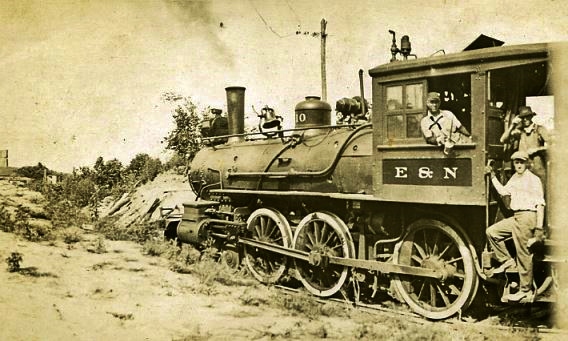Back Home by Chris Hardie
» Download this column as a Word document
» Download the photos that accompany this story
» Chris Hardie’s headshot
Travelers driving along U.S. Highway 53 through Ettrick are greeted by a welcome sign adorned with a majestic eagle that reads, “Welcome to Ettrick — Life, Liberty and the Pursuit of Happiness.”
The pursuit of those attributes helped to create an indomitable spirit more than a century ago. It was the driving force that put this Trempealeau County settlement in the history books. Proud Irish, Scottish and Scandinavian immigrants in 1917 created and built the shortest independent railway in the state of Wisconsin. They overcame many obstacles to dig the deepest railroad cut in the state.

But history also tells us the railroad came at the wrong time and its tracks were likely sent to the wrong community. Despite several attempts to make it profitable and sustainable, the last version of the Ettrick & Northern Railroad Co. went out of business in 1937.
That was well before my time but I’ve heard plenty of stories about the railroad, which ran 11 miles north from Ettrick to Blair. Many descendants of the men and women who worked to either finance the venture or to even to help lay the tracks remain in the area today.
The idea for the railroad came from local businessmen in the early 1900s who wanted better transportation for farmers than horse-drawn carts pulled over muddy and sandy roads. Cattle and commodities needed to come out of Ettrick, which had a flourishing creamery and woolen mill. The nearest railroad was either south 9 miles to Galesville — where there was an extension of the Chicago and North Western Railroad from Trempealeau — or to Blair, where the Green Bay and Western Railroad tracks were.
A 1917 history book regarding Trempealeau County written by Franklyn Curtiss-Wedge said Chicago and North Western officials were not in favor of extending the branch from Galesville. So backers formed on June 5, 1915, the Ettrick & Northern Railroad. And instead of going through the flat Beaver Creek valley to Galesville, organizers decided to go north to Blair.
The town of Ettrick bonded itself for $100,000 — the equivalent of $2 million in current dollars; others in the community also invested. The deadline for the project was Jan. 1, 1918. If it wasn’t complete by then, the bonds would be in default. What seemed like an attainable date at first loomed closer and closer without completion. The United States entered World War I. Prices soared and construction materials became scarce, as did labor. More capital was raised.
A formidable obstacle was cutting through the Blair Ridge. Businessmen, farmers and neighbors chipped in — even those who didn’t have money invested in the project. Men and women labored seven days a week to dig rock and dirt. They eventually created a cut through the ridge that was 90 feet deep, 300 feet wide and 100 feet long.
The hard work paid off; it was Dec. 26, 1917, when the first train rolled over the tracks. The deadline had been met. Freight was the only cargo for the first few months of 1918 before passenger service began that fall. It was a no frills service. There was no turntable at the beginning, so the coal-fired 1896 engine would make the run from Blair back to Ettrick in reverse. The usual freight was livestock, mail, lumber, cucumbers and other farm goods.
Work and maintenance on the track continued. Tragedy struck Sept. 10, 1918, when Herman Noren of Franklin was killed after being hit by the steam-shovel bucket.
The train eventually made two round trips daily except Sunday, from Ettrick to Blair, with a stop at Annakay Station near Beach Corners. But passengers could disembark or climb on anywhere along the route; there were reports of youngsters jumping on and off the train.
A Feb. 27, 1919, report in the Galesville Republican newspaper said there was a Friday-night dance in Blair; 40 dancers paid 25 cents each to ride from Ettrick. A reciprocal dance was scheduled the next Friday in Ettrick.
In an effort to save costs, the railroad purchased a Model T truck that was fitted for the rails. It was used for smaller runs — saving the costs of needing to staff a full crew. There’s a story about a group of Ettrick kids who unhooked the truck from the car one Halloween and went for a joyride to Blair.
But the railroad struggled financially, detailed in a chapter of the book “Twilight Rails” by H. Roger Gran. Additional bonds were sought in 1921 with the slogan “Let’s keep the whistle ‘tootin’ and the bell ringing.” The referendum was approved, but the results were challenged by a town resident and were overturned.
The railroad went through bankruptcy in 1922 but additional funds kept it operating. An accident in December 1926 that wrecked cars on the Blair Ridge was the final straw. The Ettrick & Northern — also called the Ettrick & Nothing by some — went out of business.
Shortly after the railroad was sold for scrap, a new effort emerged. Local businessman Maurice Casey and others bought the railroad at auction for $7,000. Casey had won a coin flip with a New York investor who also had an interest.
Another Ettrick businessman, Obel Pederson, also invested. The newly formed Ettrick Railroad Co. spent $20,000 to purchase a new and more-efficient diesel engine, and to repair bridges and tracks. Despite the improvements, passenger service was discontinued. Bus service had come to Ettrick in 1923 and the highways were starting to be paved and improved. Automobile transportation was more common.
The railroad lasted until 1937. The Interstate Commerce Commission approved abandonment of the line just four months after the town of Ettrick made its final bond payments. What had cost $300,000 to $350,000 to build — about $5.4 million in today’s dollars — was eventually sold as scrap to a Michigan company, for just $7,000.
The age of the iron horse in Ettrick was over.
Today, all that remains of the railroad is the old depot next to the Ettrick Fire Station, with an adjacent Quonset hut. The Green Bay and Western depot in Blair also stands. The cut through Blair Ridge was partially filled in; it’s east of U.S. Highway 53.
Perhaps if the railroad had run the other direction to Galesville — which would have been less expensive to build — or if it would have come a few decades earlier when costs were cheaper, the railroad may have survived longer. But the fact that one town and its proud population overcame many obstacles and hardships to make their railroad dream a reality at all is a testament to hard work and determination shared by many.
The railroad is gone but the story remains of “the little town that could.”
Chris Hardie spent more than 30 years as a reporter, editor



